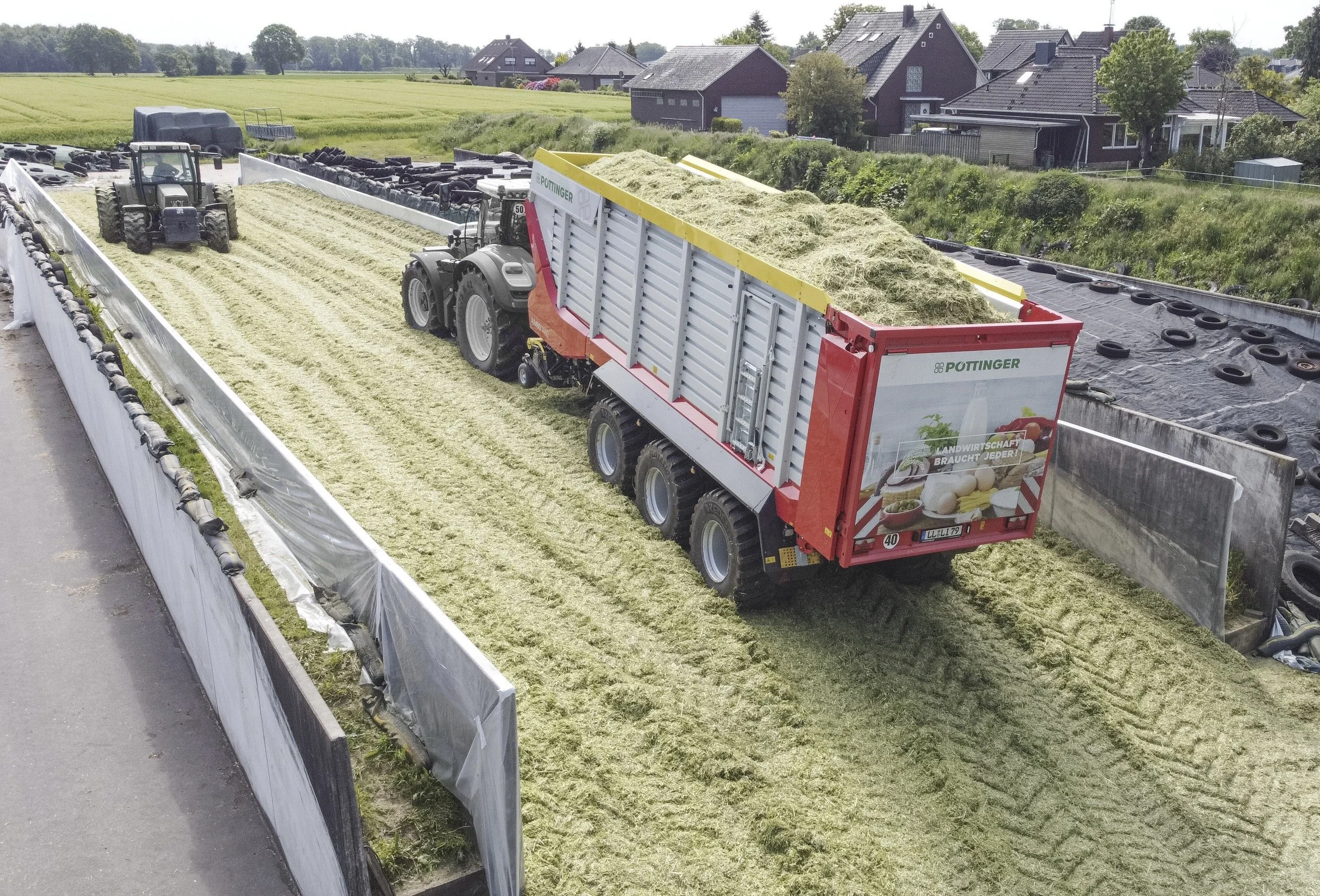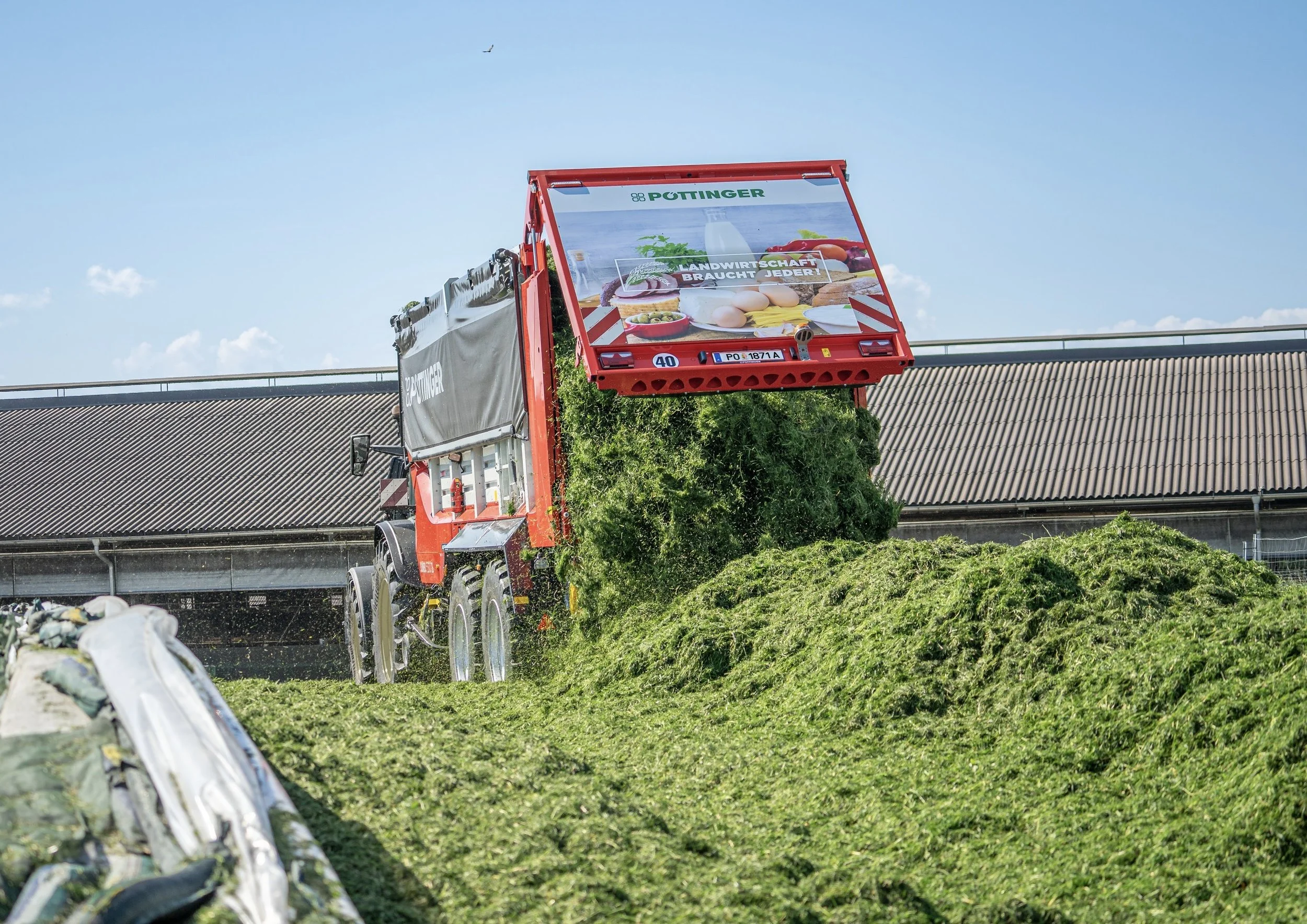What is the best way to fill a silage clamp?
An Irishman, an Englishman and a German went into this pub and…… oh hang on isn’t that the opening to a slightly un-PC 1970’s joke? Stereotypical humour doesn’t quite have the audience that it once did but there are still some stereotypical traits that do still hold true when it comes to making silage. Now I’m not going out on a limb here, I’m just quoting some actual real life research that JCB carried out when developing the latest updates for its 435S loading shovel.
There seems to be some real cultural differences between how we make our silage in this corner of north western Europe; so much so that manufacturers are designing machines specifically to suit the different customer groups. The Irish love to build a steep clamp with a ramp that resembles the north face of the Eiger, whilst the Germans build a clamp that has more in common the the flat lands of the neighbouring Netherlands. And the English? Well that’s probably something in between these two extremes. Steep or shallow, high or low, what is the best way to fill a silage clamp?
A Pottinger Jumbo on a “drive over” European clamp
So that’s what they do and how they do it, but it begs two further questions, why, and which one is correct?
Before we go any further, I need to come clean because I’m an Englishman so my opinion will be biased (obviously) but I will try and unpick this as an independent.
Why are European silage clamps lower than those in the UK?
Now it’s not just the Germans that favour a low clamp. Throughout my European road trips I scan the landscape for silage clamps and my inbuilt height detector reads walls that are typically 1.5m to 2.0m high. That’s much lower than back home so why is this? We know that local European precast concrete manufactures supply wall panels that can go up to 4m high for silage so it's not a lack of wall options that hold back clamp height.
Once you look at the average herd size in Germany and France you can start to understand what’s going on here. In the UK the average herd size is now just under 220 cows; in Germany this figure is 76 cows and in France it’s around 60 cows. It’s not just the average herd size that matters, its also the fact that there are large numbers of farmers in the 40-80 cow range. That means there are loads of farmers making relatively small volumes of silage (compared to the UK).
How to control losses in a small silage clamp?
To control and minimise the aerobic losses, these low volume silage clamps have to offer a small face area. The best way to do this without making a clamp ridiculously narrow, is to make the height lower. Its not exactly a cheap way to store silage, but it will ultimately be cost effective because losses are almost aways more expensive than construction in the long run!
Now because the silage is only stored to 1.5m or 2.0m height, there is no real opportunity to build a wedge. This is led to the practice of “drive over” clamps where forage wagons, or similar walking floor discharge trailers, drive over the clamp and unload as they go. This removes the need for the buck-rake to carry, or push, the silage up the clamp. The combined weight of the tractor and trailer also do a good job of compacting the forage too.
Rear discharge forage wagon by Pottinger
It sounds like a great idea, so why don’t we all drive over our silage clamps?
It might seem like a great idea but there are a number of problems with this practice, and I’m not a massive fan of it. Firstly the clamp needs to be laid out for this type of operation right from the start. To work effectively the clamp needs to be open at both ends to allow the full trailer to drive on and the empty trailer to drive off in a straight line. Secondly the walls need to be designed for the loads of a fully laden tractor and trailer driving around on top of the silage.
The law of levers comes into play here, because the higher the walls are, the more difficult it is for the structure to resist the loads. The leverage effect has a massive multiplying factor on the loads; so increasing the walls from 1.5m to 3.0m is much more than just doubling the height. The ultimate moment, the rotational force at the base of the wall, is around 6 times greater in a 3m high wall than a 1.5m wall!
Tipping trailers on top of a silage clamp is obviously an absolute no-no, because the whole lot is sitting on a relatively unstable base - with an ever increasing centre of gravity. But even if you are using an ejector or moving floor trailer there is still a much greater risk of the trailer tipping over on a deeper pile of silage than there is on a shallow one. So this all leads to a lower wall height and shallow silage depth. Even then I still don’t like the fact that the field tractors are driving up and over the forage with tyres that are covered in millions of unhelpful microbes.
Why do the Irish do silage differently?
So that’s why the Germans make shallow clamps, but why do the Irish build clamps so steeply? Well I’m not exactly qualified to answer this but it’s not got much to do with average herd size because the typical Irish dairy herd is only just over 100 cows. Whilst it’s significantly larger than the French or German dairy herd, on its own, this factor is not a big enough difference to result in a completely opposite clamp filling tradition.
Squeezing silage into every corner
I am led to believe that the Irish practice has evolved just as the whole dairy industry has evolved. Most of the dairy farms in Ireland are traditional in so much as they have been dairy farms for many many years. This means many of the buildings and yards were originally designed for a herd a fraction the size of the current herd. This expansion has been evolutionary rather than revolutionary which means cows have been added in 10’s rather than 100’s at a time.
To cope with a few extra cows and a few extra acres, clamps have been stretched or “heaped up a bit” and where this is in a building it means that headroom has been stolen. A smaller tractor on top can still roll silage stacked up by a big shovel working on the ramp. To cope with this “quart into a pint pot” problem, the ingenious Irish buck-rake driver has become an expert in silage Jenga. Shoving grass into every available inch of the silage shed or clamp.
Filling a silage clamp the Irish way has a number of efficiencies though. It all comes down to some simple physics because although the buck-rake needs some serious shove to push the forage up the steep ramp, the actual distance the forage is moved is reduced compared to a layer solution. This makes it a quicker and ultimately more efficient way to fill a silage clamp.
Is the Dorset wedge the best way to fill a silage clamp?
The Irish are maybe building the most extreme type of Dorset wedge, so why don’t the English do this too because, after all, Dorset is in England. Traditionally the Dorset wedge was the advised way to form a clamp, constantly adding to the ramp rather than the top of the clamp.
Today this is not so common in England as the Dorset wedge has fallen out of favour, and I am happy with this despite my wife being a Dorset girl. As dry matters have improved and chop lengths have reduced, the wedge technic has been exposed as producing clamps that are at risk of slippage during feed out. Maybe the Dorset wedge was suitable back when double chop was the thing and the longer forage length knitted the silage together more, but I have seen too many “face slips” on wedge filled clamps. And silage that has been rolled on a slope is never as tight as the stuff that’s been rolled on the flat….. but that’s another story.
Layering silage into the clamp with a 435S for SW-Hire
So the English way of filling the silage clamp is a bit of a hybrid, an evolution of what we did in the past but without going the whole hog and joining the Europeans - oh that’s so very English…. In my opinion, this solution does allow you to make good silage, with excellent compaction and a stable exposed face - but then again, as I said earlier, I’m probably biased!
If you want to discuss how to best fill your silage clamp or would like to discuss any other aspects covered in this series, contact me at jeremy@silageconsultant.co.uk



